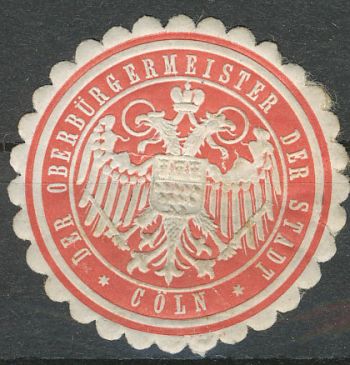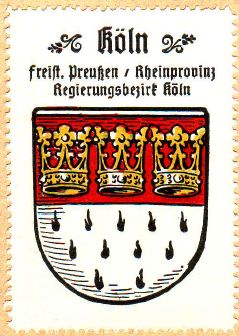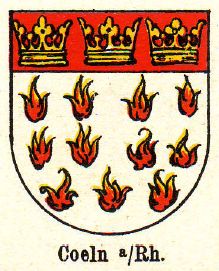Köln: Difference between revisions
Knorrepoes (talk | contribs) No edit summary |
(German and english blason added refered to Nagel) |
||
| Line 14: | Line 14: | ||
====Official blazon==== | ====Official blazon==== | ||
*(de)Ein golden (gelb) nimbierter, golden (gelb) bewehrter, rot gezungter schwarzer Doppeladler mit silbernem (weißem) Schwert und goldenem (gelbem) Zepter in den Fängen, über den Köpfen schwebend eine goldene (gelbe) Kaiserkrone; im Brustschild unter rotem Schildhaupt, darin nebeneinander drei goldene (gelbe) Kronen, in Silber (Weiß) 11 schwarze Flammen im Verhältnis 5:4:2. | |||
*(en)A double-headed eagle sable, holoed Or, armed, beaked and membered gules, in the claws a sword Argent and a sceptre Or, between the heads an imperial crown coped Or; charged with a breast shield: a chief gules, charged with three crowns Or, Argent, 11 flames sable in ratio 5:4:2. | |||
====Origin/meaning==== | ====Origin/meaning==== | ||
| Line 35: | Line 38: | ||
[[Literature]] : Stadler, K. : Deutsche Wappen - Bundesrepublik Deutschland. Angelsachsen Verlag, 1964-1971, 8 volumes. | [[Literature]] : Stadler, K. : Deutsche Wappen - Bundesrepublik Deutschland. Angelsachsen Verlag, 1964-1971, 8 volumes. | ||
Nagel, Rolf: Rheinisches Wappenbuch. Rheinland-Verlag, Köln 1986; S. 119 ISBN 3-7927-0816-7 | |||
[[Category:German Municipalities K|Koln]] | [[Category:German Municipalities K|Koln]] | ||
Revision as of 13:49, 25 February 2014
| Heraldry of the World Civic heraldry of Germany - Deutsche Wappen (Gemeindewappen/Kreiswappen) |
KÖLN
State : Nordrhein-Westfalen
Urban District (Kreisfreie Stadt) : Köln
Additions : 1888 Bayenthal, Bickendorf, Bilderstöckchen, Bocklemünd, Braunsfeld, Deutz, Ehrenfeld, Heimersdorf, Humboldt, Kalk, Klettenberg, Lindenthal, Lindweiler, Marienburg, Mauenheim, Müngersdorf, Neuehrenfeld, Niehl, Nippes, Ossendorf, Poll, Raderberg, Raderthal, Riehl, Sülz, Vogelsang, Volkhoven, Weidenpesch, Zollstock; 1914 Brück, Buchforst, Buchheim, Dellbrück, Dünnwald, Flittard, Höhenhaus, Holweide, Merheim, Mülheim am Rhein, Ostheim, Rath, Stammheim, 1922 Chorweiler, Fühlingen, Merkenich, Roggendorf/Thenhoven, Seeberg, Worringen, 1975 Eil, Elsdorf, Ensen, Esch/Auweiler, Godorf, Gremberghoven, Grengel, Hahnwald, Immendorf, Junkersdorf, Langel, Libur, Lind, Lövenich, Meschenich, Pesch, Porz, Rodenkirchen, Sürth, Urbach, Wahn, Wahnheide, Weiden, Weiss, Westhoven, Widdersdorf, Zündorf; 1989 Blumenberg; 1993 Neubrück
Official blazon
- (de)Ein golden (gelb) nimbierter, golden (gelb) bewehrter, rot gezungter schwarzer Doppeladler mit silbernem (weißem) Schwert und goldenem (gelbem) Zepter in den Fängen, über den Köpfen schwebend eine goldene (gelbe) Kaiserkrone; im Brustschild unter rotem Schildhaupt, darin nebeneinander drei goldene (gelbe) Kronen, in Silber (Weiß) 11 schwarze Flammen im Verhältnis 5:4:2.
- (en)A double-headed eagle sable, holoed Or, armed, beaked and membered gules, in the claws a sword Argent and a sceptre Or, between the heads an imperial crown coped Or; charged with a breast shield: a chief gules, charged with three crowns Or, Argent, 11 flames sable in ratio 5:4:2.
Origin/meaning
Köln (Cologne) was one of the most important towns in Germany. It got city rights early in the 12th century. The oldest seals, dating from 1149, only showed St. Peter, the patron saint of the city. The saint itself, nor its symbol, two crossed keys, appeared in the arms of the city itself. They do appear, together with a black cross, the symbol of the State of Köln, in many civic arms around the city (see f.e. Xanten).
The three crowns, symbolising the three Holy Kings, first appeared in 1315, in a chief above a silver shield. Relics of the Three Kings were taken to the city in 1164 by Emperor Friedrich Barbarossa. Later (around 1500) the shield was 'filled' with ermine. Officially there are 11 ermine tails, symbolising the 11.000 virgins of Saint Ursula. As St. Ursula was a princess of Bretagne (Brittany) the virgins were depicted as ermine tails. The arms of Brittany are a plain shield of ermine.
The original description in the legend of St. Ursula read XI m. virg. This has to be translated as 11 martyred virgins, not as 11.000 (M for 1000) virgins...
The colours of the shield are the colours of the Hanseatic league, the major league of merchant cities in the early Middle Ages. Köln was a founding member of the league.
The Imperial Eagle was granted in the 15th century and symbolised the rank of free imperial city. The arms were granted in 1817 and confirmed in 1897.
| Seal from around 1900 |
The arms in the Kaffee Hag albums +/- 1925 |
| The arms as shown around 1900 |
The arms as shown around 1900 |
Literature : Stadler, K. : Deutsche Wappen - Bundesrepublik Deutschland. Angelsachsen Verlag, 1964-1971, 8 volumes. Nagel, Rolf: Rheinisches Wappenbuch. Rheinland-Verlag, Köln 1986; S. 119 ISBN 3-7927-0816-7




